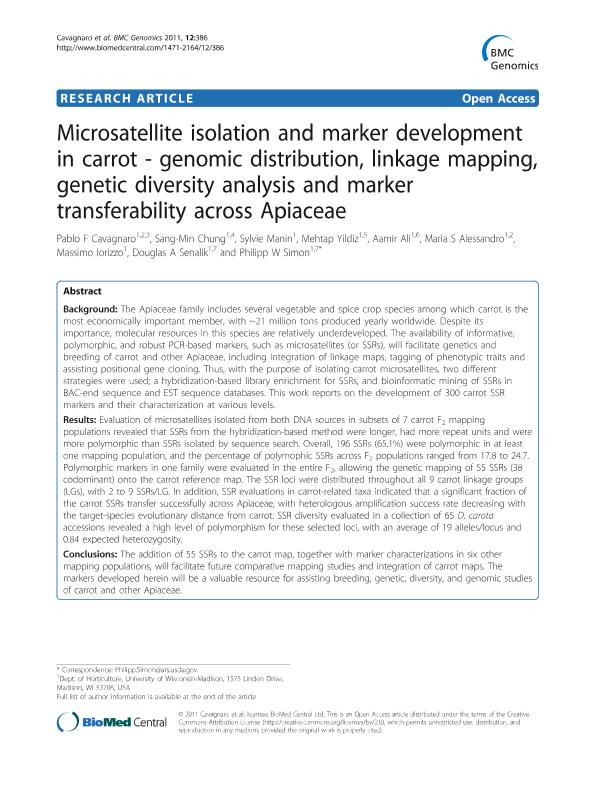Mostrar el registro sencillo del ítem
dc.contributor.author
Cavagnaro, Pablo Federico

dc.contributor.author
Chung, Sang Min
dc.contributor.author
Manin, Sylvie
dc.contributor.author
Yildiz, Mehtap
dc.contributor.author
Ali, Aamir
dc.contributor.author
Alessandro, María Soledad

dc.contributor.author
Iorizzo, Massimo
dc.contributor.author
Senalik, Douglas A.

dc.contributor.author
Simon, Philipp W.
dc.date.available
2017-07-13T21:23:25Z
dc.date.issued
2011-08-01
dc.identifier.citation
Cavagnaro, Pablo Federico; Chung, Sang Min; Manin, Sylvie; Yildiz, Mehtap; Ali, Aamir; et al.; Microsatellite isolation and marker development in carrot - genomic distribution, linkage mapping, genetic diversity analysis and marker transferability across Apiaceae; Biomed Central; Bmc Genomics; 12; 1-8-2011; 386-406
dc.identifier.issn
1471-2164
dc.identifier.uri
http://hdl.handle.net/11336/20450
dc.description.abstract
Background: The Apiaceae family includes several vegetable and spice crop species among which carrot is the most economically important member, with ~21 million tons produced yearly worldwide. Despite its importance, molecular resources in this species are relatively underdeveloped. The availability of informative, polymorphic, and robust PCR-based markers, such as microsatellites (or SSRs), will facilitate genetics and breeding of carrot and other Apiaceae, including integration of linkage maps, tagging of phenotypic traits and assisting positional gene cloning. Thus, with the purpose of isolating carrot microsatellites, two different strategies were used; a hybridization-based library enrichment for SSRs, and bioinformatic mining of SSRs in BAC-end sequence and EST sequence databases. This work reports on the development of 300 carrot SSR markers and their characterization at various levels. Results: Evaluation of microsatellites isolated from both DNA sources in subsets of 7 carrot F2 mapping populations revealed that SSRs from the hybridization-based method were longer, had more repeat units and were more polymorphic than SSRs isolated by sequence search. Overall, 196 SSRs (65.1%) were polymorphic in at least one mapping population, and the percentage of polymophic SSRs across F2 populations ranged from 17.8 to 24.7. Polymorphic markers in one family were evaluated in the entire F2, allowing the genetic mapping of 55 SSRs (38 codominant) onto the carrot reference map. The SSR loci were distributed throughout all 9 carrot linkage groups (LGs), with 2 to 9 SSRs/LG. In addition, SSR evaluations in carrot-related taxa indicated that a significant fraction of the carrot SSRs transfer successfully across Apiaceae, with heterologous amplification success rate decreasing with the target-species evolutionary distance from carrot. SSR diversity evaluated in a collection of 65 D. carota accessions revealed a high level of polymorphism for these selected loci, with an average of 19 alleles/locus and 0.84 expected heterozygosity. Conclusions: The addition of 55 SSRs to the carrot map, together with marker characterizations in six other mapping populations, will facilitate future comparative mapping studies and integration of carrot maps. The markers developed herein will be a valuable resource for assisting breeding, genetic, diversity, and genomic studies of carrot and other Apiaceae
dc.format
application/pdf
dc.language.iso
eng
dc.publisher
Biomed Central

dc.rights
info:eu-repo/semantics/openAccess
dc.rights.uri
https://creativecommons.org/licenses/by-nc-sa/2.5/ar/
dc.subject
Carrot
dc.subject
Microsatellites
dc.subject
Genetic Map
dc.subject.classification
Biotecnología Agrícola y Biotecnología Alimentaria

dc.subject.classification
Biotecnología Agropecuaria

dc.subject.classification
CIENCIAS AGRÍCOLAS

dc.title
Microsatellite isolation and marker development in carrot - genomic distribution, linkage mapping, genetic diversity analysis and marker transferability across Apiaceae
dc.type
info:eu-repo/semantics/article
dc.type
info:ar-repo/semantics/artículo
dc.type
info:eu-repo/semantics/publishedVersion
dc.date.updated
2017-04-07T13:41:00Z
dc.journal.volume
12
dc.journal.pagination
386-406
dc.journal.pais
Reino Unido

dc.description.fil
Fil: Cavagnaro, Pablo Federico. Instituto Nacional de Tecnología Agropecuaria. Centro Regional Cuyo Mendoza-san Juan. Estación Experimental Agropecuaria la Consulta; Argentina. University of Wisconsin-Madison. Department. of Horticulture; Estados Unidos. Consejo Nacional de Investigaciones Científicas y Técnicas. Centro Científico Tecnológico Conicet - Mendoza; Argentina
dc.description.fil
Fil: Chung, Sang Min. University of Wisconsin-Madison. Department. of Horticulture; Estados Unidos. Dongguk University. Department of Life Science; Estados Unidos
dc.description.fil
Fil: Manin, Sylvie. University of Wisconsin-Madison. Department. of Horticulture; Estados Unidos. Yuzuncu Yil
University. Faculty of Agriculture, Department of Horticulture; Turquía
dc.description.fil
Fil: Yildiz, Mehtap. University of Wisconsin-Madison. Department. of Horticulture; Estados Unidos. Yuzuncu Yil University. Faculty of Agriculture. Department. of Horticulture; Corea del Sur
dc.description.fil
Fil: Ali, Aamir. University of Wisconsin-Madison. Department. of Horticulture; Estados Unidos. University of Sargodha. Department of Biological Sciences; Pakistán
dc.description.fil
Fil: Alessandro, María Soledad. University of Wisconsin-Madison. Department. of Horticulture; Estados Unidos. Instituto Nacional de Tecnología Agropecuaria. Centro Regional Mendoza-san Juan. Estación Experimental Agropecuaria la Consulta; Argentina
dc.description.fil
Fil: Iorizzo, Massimo. University of Wisconsin-Madison. Department. of Horticulture; Estados Unidos
dc.description.fil
Fil: Senalik, Douglas A.. University of Wisconsin-Madison. Department. of Horticulture; Estados Unidos. University of Wisconsin-Madison. Department of Horticulture. USDA-ARS. Vegetable Crops Unit; Estados Unidos
dc.description.fil
Fil: Simon, Philipp W.. University of Wisconsin-Madison. Department. of Horticulture; Estados Unidos. University of Wisconsin-Madison. Department of Horticulture. USDA-ARS. Vegetable Crops Unit; Estados Unidos
dc.journal.title
Bmc Genomics

dc.relation.alternativeid
info:eu-repo/semantics/altIdentifier/url/https://bmcgenomics.biomedcentral.com/articles/10.1186/1471-2164-12-386
dc.relation.alternativeid
info:eu-repo/semantics/altIdentifier/doi/http://dx.doi.org/10.1186/1471-2164-12-386
Archivos asociados
